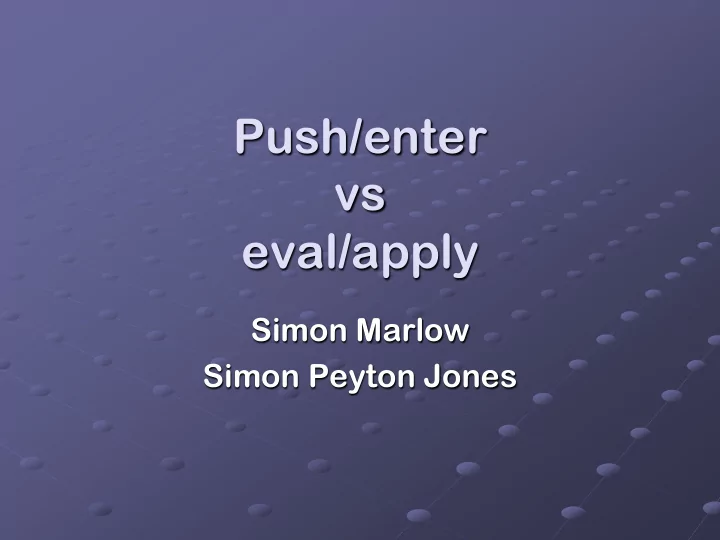

Push/enter vs eval/apply Simon Marlow Simon Peyton Jones
The question Consider the call (f x y). We can either Eval aluate uate f, and then apply ly it to its arguments, or Pu Push x and y, and ent nter er f Both admit fully-general tail calls Which is better?
Push/enter for (f x y) Stack of "pending arguments" Push y, x onto stack, enter (jump to) f f knows its own arity (say 1). It checks there is at least one argument on the stack. Grabs that argument, and executes its body, then enters its result (presumably a function) which consumes y
Eval/apply for (f x y) Caller evaluates f, inspects result, which must be a function. Extracts arity from the function value. (Say it is 1.) Calls fn passing one arg (exactly what it is expecting) Inspects result, which must be a function. Extracts its arity... etc
Known functions Often f is a known function let f x y = ... in ...(f 3 5).... In this case, we know f's arity statically; just load the arguments into registers and call f. This "known function" optimisation applies whether we are using push/enter or eval/apply So we only consider unknown calls from now on.
Uncurried functions If f is an uncurried function: f :: (Int,Int) -> Int ....f (3,4)... Then a call site must supply exactly the right number of args So matching args expected by function with args supplied by call site is easier (=1). But we want efficient curried functions too And, in a lazy setting, can't do an efficient n- arg call for an unknown function, because it might not be strict.
Push/enter vs eval/apply When calling an unknown function: the call site knows how many args are supplied the function knows how many args it is expecting Push/enter: function inspects data structure describing arguments Eval/apply: call site inspects data structure describing function
Push/enter vs eval/apply Both are reasonable for both strict and lazy evaluators Traditionally, strict languages have used eval/apply (Lisp interpreter), while lazy ones have used push/enter (G-machine, TIM..) Push/enter does handle currying particularly elegantly GHC has always used push/enter
But no one knows which better Typically built rather deeply into an implementation Hence, hard to implement both Hence no good way to compare the two So implementors just stick their finger in the air We aim to close the question
Implementing push/enter Two entry points for each function: "fast" for known calls "slow" for unknown calls “Su” register points to deepest pending argument; so Sp-Su gives # of pending args Save/restore Su when pushing an update frame
Push/enter example let x = f 3 in ... where f has arity 2 Su f sees that there is only Sp one argument on Update stack, so it frame Old • Updates the closure 3 Su for x with (f 3) • Removes the update 1 arg on stack frame Closure for x • And looks for further arguments
Implementing eval/apply For unknown (f x y), jump to RTS code apply2(f,x,y) passing x,y in registers The RTS code evaluates f, tests arity etc RTS apply code is mechanically generated for many common patterns (apply2, apply3 etc) Exception cases by repeated calls
Call patterns (unknown calls)
Subtle costs Push/enter has non-obvious costs Difficulties with stack/walking Difficult to compile to C-- Burns a register (Su) to maintain current pending- arg count (+ need for save/restore in each update frame) Two entry points tiresome when hand-writing RTS built-ins
Stack-walking in push/enter Pending Return Return arguments address address describes stack frame Problem: distinguishing pending args from return addresses
Distinguishing return addresses Distinguish unboxed pending args with tags Could also do that with pointer args, but expensive (2 words/arg) We never found a satisfactory way of distinguishing return addresses from pending pointer args Address based schemes fail with dynamic linking; and OS fragility
Compiling to C-- We'd like to compile to C-- But the push/enter stack discipline is alien to C-- (because of the pending args) Unable to find a decent abstraction for C-- that accommodates pending args. Unsatisfactory fall-backs: separate pending arg stack ignore C-- stack, manage stack by hand
Qualitative conclusion With deep reluctance I am forced to declare that Eval/apply is a significantly simpler implementation technology for high- performance compilers
But how does it perform?
Conclusions Eval/apply does not change performance much either way But it's significantly simpler to think about and implement Complexity is located in one place (the RTS apply code), which can be hand tuned Less complexity elsewhere The balance is probably different for an interpreter Paper at http://research.microsoft.com/~simonpj
Recommend
More recommend